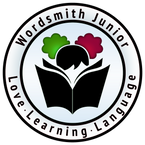Fifth Blog by gRandma gRace
In mid April, we participated as guests in the Jester and Pharley Pfund booth in the
annual Los Angeles Times Book Festival. It was held at the University of Southern
California and although it rained the first day, we learned a lot about how book
festivals work. We were blessed to meet some fabulous people, bought some great
books and sold our books as well. Wordsmith Jr, LLC would like to take this moment
to give a special thanks to Mr. Craig Keys, associate Senior Vice President for Civic
Engagement, at USC, his staff, and the Saltzman family for giving us a venue and for
welcoming us so warmly. When I was initially invited, I was to read a Wordsmith Jr,
LLC book to a group of students being hosted by USC along with other new authors.
However, Scholastic Books bought out this entire venue and only wanted their
books read. After being disinvited to read in this venue, we did what we so often do
– we regrouped, enjoyed and engaged the many people who walked around the
outside booths and stopped by to visit us.

I also walked around to visit the other booths and learned that the Wordsmith Jr,
LLC books do indeed fill a current void. Although there are great books available
featuring children of color, we did not see any that featured children of color with a
targeted emphasis on literacy. We truly focused on the research regarding the
learning of children, particularly African American children, and used this research
to inform how our books are written, designed, formatted and illustrated.
There are five research-based elements that we incorporated in our books:
1. High expectations through use of high level vocabulary in all books – There is
a long tradition of research where high expectations lead to higher performance
among students of all races and classes.
2. Inclusion of movement and action in all books – Dr. A. Wade Boykin defined
verve as having energy, being intense, and having expressive body language,
which also implies a propensity to remain stimulating and lively. His research
shows that Black children do better in understanding and retention of materials
that are ‘vervistic.’ as Dr. A. Wade Boykin would describe them. In other words,
our books intentionally include movement and action.
3. Positive self-esteem through images of self in the books – Educator and
teacher trainer, Dr. Mack T. Hines, III states “When a teacher presents a picture
of learning and you are not in it, you become an afterthought of accountability,
and your life and experiences will not find a mirror in the classroom.” Children’s
self-esteem is enhanced when they see positive images of themselves. Our books
focus on African-American children, as these children are often not often
presented in current literacy curriculum.
4. Character building is embedded in all of our books (kindness, helping others,
sharing) – Jessica Lahey states in an Article in Atlantic (2013) that “Character
education is not old-fashioned, and it’s not about bringing religion in to the
classroom. Character is the ‘X factor’ that experts in parenting and education
have deemed integral to success.” We have included overt and subtle character
qualities in our books.
5. Rhyme is used in 8 of our 12 books (not in Akira series) – Rhyming is a
mnemonic technique that many of our children enjoy. This is evidenced in how
very young children can memorize nursery rhymes and even complex rap lyrics.
All of our books are intended for out-loud reading to our children. They are
designed to foster social interaction between the reader and the listener(s).
Research has shown that social interaction is a major contributor to brain health,
along with exercise and a nutritious diet.

